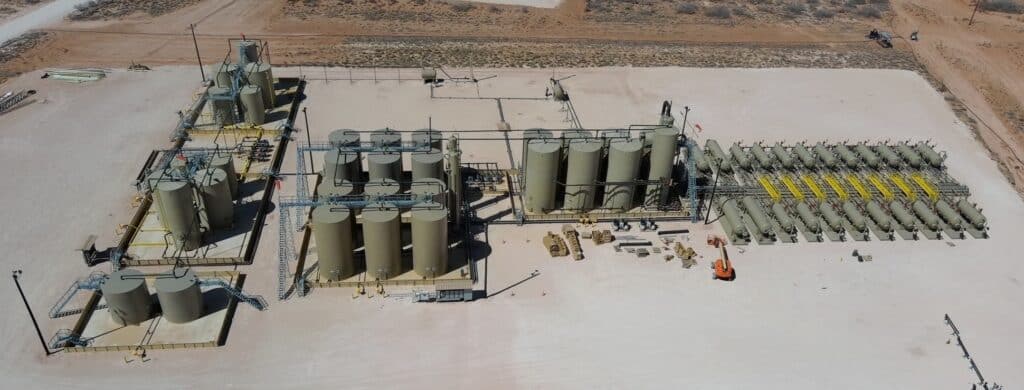by Bill Ball

The oil and gas industry is no stranger to change, but the last few decades have seen a truly revolutionary shift, particularly with the adoption of Plug-and-Play (PnP) technology. PnP, once a term coined for easy-installation computer components, has now found its place in oil production, drastically transforming how companies design and build Central Tank Batteries (CTBs).
What is Plug-and-Play (PnP) Technology in Oil and Gas?
PnP technology simplifies the integration of components within a system, allowing new equipment to be easily added or replaced without major modifications. This concept, which started in the tech world, has transitioned to oilfield operations, where efficiency and adaptability are key. The ability to swap out oversized or undersized process equipment on demand is reducing costly downtime and making oil production more responsive to fluctuating well outputs.
In the past, oil companies took a reactive approach to acquiring and assembling CTB components, slowing down production. With PnP, the industry has shifted to a more proactive model, stocking essential parts in advance to speed up construction and avoid delays.
The Rise of Horizontal Drilling and Its Challenges
One of the most significant innovations reshaping the oil and gas landscape is horizontal well drilling. Unlike traditional vertical wells, horizontal wells are designed to tap into previously inaccessible oil reserves, dramatically increasing production rates. However, this rapid production comes with a unique challenge: horizontal wells experience steep production declines.
This is where PnP technology steps in. As production rates drop, oversized equipment becomes inefficient, leading to poor performance and inaccurate metering. PnP systems solve this problem by allowing operators to scale down process equipment to match current production levels. The ability to quickly swap out separators, treaters, and other components means better performance and more reliable data for engineers managing the wells.
The Walmart Inventory Philosophy: Lessons Learned
Another key influence on the PnP revolution in CTB design comes from an unlikely source: Walmart. EOG Resources, a pioneer in adopting PnP in oil production, took inspiration from Walmart’s “always in stock” philosophy. By ensuring all necessary components were available on-site, EOG was able to construct more CTBs at a faster rate than ever before, allowing them to keep pace with booming production from their horizontal wells.
This strategy proved so successful that other oil companies quickly followed suit. Stockpiling essential equipment and standardizing CTB designs not only minimized construction time but also helped reduce capital expenditure (CAPEX) by repurposing equipment from declining wells for new projects.
The Future of CTB Design with PnP Technology
Today, CTBs built with PnP systems are pushing the boundaries of oil production efficiency. Skid-mounted, pre-piped equipment allows for seamless integration and scaling, reducing downtime and CAPEX while maximizing operational efficiency. KBK Industries has been at the forefront of this innovation, offering state-of-the-art solutions like the patented DFSD® (De-Sanding Degassing Flow-Splitting) tanks, which optimize separation and metering even as production rates fluctuate.
With horizontal well technology continuing to evolve, PnP will play an increasingly crucial role in maintaining the profitability and sustainability of oilfield operations. As more companies embrace this approach, the industry as a whole will benefit from faster construction timelines, better data accuracy, and reduced operational costs.
Conclusion
PnP technology is transforming CTB design and oil production as a whole. By adopting this 21st-century approach, oil companies are not only improving their efficiency but also ensuring long-term profitability in an industry where adaptability is key. As the oilfield continues to innovate, PnP will remain a vital tool in the ongoing quest for better performance and reduced downtime.
By focusing on the synergy between PnP and evolving drilling technologies, operators can stay ahead of the curve and unlock the full potential of modern oil production techniques. To learn more about how PnP can enhance your facility’s efficiency, contact KBK Industries today.
Read the technical paper, “PnP” A 21st Century Technology That may be Right for You!
Bill Ball is a senior staff consultant to KBK Industries with over 50 years of oilfield engineering experience and holder of twenty-three oil and gas industry related US patents. His credentials represent the culmination of a lifetime of breakthroughs and innovations. Bill’s twenty-three US process equipment patents speak to this. His first patent has become an industry “game changer.” It is the industry’s first true oil-water separation “skim tank”, the “HWSB”. Today there are over 3,500 HWSB® skim tanks separating and capturing oil that used to be injected and lost forever. Bill resides in Bixby, a suburb of Tulsa, Oklahoma.
